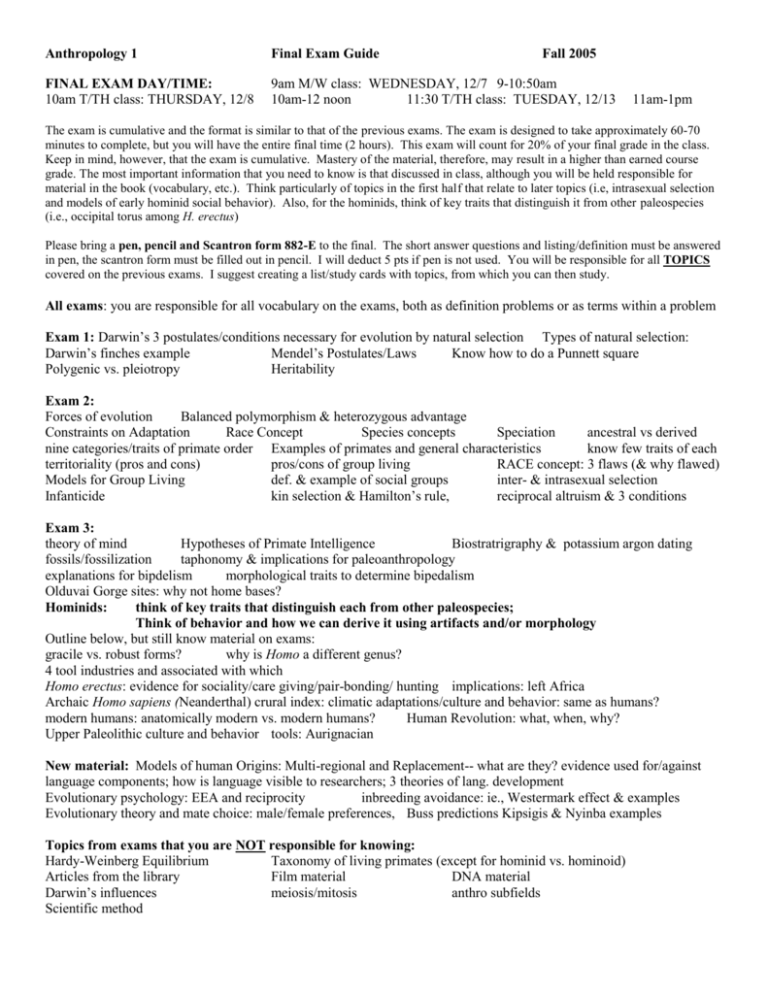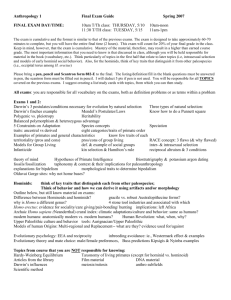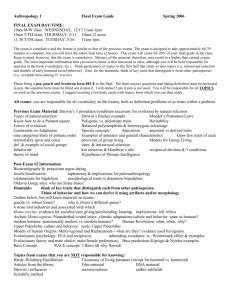Anthropology 101
advertisement

Anthropology 1 Final Exam Guide Fall 2005 FINAL EXAM DAY/TIME: 10am T/TH class: THURSDAY, 12/8 9am M/W class: WEDNESDAY, 12/7 9-10:50am 10am-12 noon 11:30 T/TH class: TUESDAY, 12/13 11am-1pm The exam is cumulative and the format is similar to that of the previous exams. The exam is designed to take approximately 60-70 minutes to complete, but you will have the entire final time (2 hours). This exam will count for 20% of your final grade in the class. Keep in mind, however, that the exam is cumulative. Mastery of the material, therefore, may result in a higher than earned course grade. The most important information that you need to know is that discussed in class, although you will be held responsible for material in the book (vocabulary, etc.). Think particularly of topics in the first half that relate to later topics (i.e, intrasexual selection and models of early hominid social behavior). Also, for the hominids, think of key traits that distinguish it from other paleospecies (i.e., occipital torus among H. erectus) Please bring a pen, pencil and Scantron form 882-E to the final. The short answer questions and listing/definition must be answered in pen, the scantron form must be filled out in pencil. I will deduct 5 pts if pen is not used. You will be responsible for all TOPICS covered on the previous exams. I suggest creating a list/study cards with topics, from which you can then study. All exams: you are responsible for all vocabulary on the exams, both as definition problems or as terms within a problem Exam 1: Darwin’s 3 postulates/conditions necessary for evolution by natural selection Types of natural selection: Darwin’s finches example Mendel’s Postulates/Laws Know how to do a Punnett square Polygenic vs. pleiotropy Heritability Exam 2: Forces of evolution Balanced polymorphism & heterozygous advantage Constraints on Adaptation Race Concept Species concepts Speciation ancestral vs derived nine categories/traits of primate order Examples of primates and general characteristics know few traits of each territoriality (pros and cons) pros/cons of group living RACE concept: 3 flaws (& why flawed) Models for Group Living def. & example of social groups inter- & intrasexual selection Infanticide kin selection & Hamilton’s rule, reciprocal altruism & 3 conditions Exam 3: theory of mind Hypotheses of Primate Intelligence Biostratrigraphy & potassium argon dating fossils/fossilization taphonomy & implications for paleoanthropology explanations for bipdelism morphological traits to determine bipedalism Olduvai Gorge sites: why not home bases? Hominids: think of key traits that distinguish each from other paleospecies; Think of behavior and how we can derive it using artifacts and/or morphology Outline below, but still know material on exams: gracile vs. robust forms? why is Homo a different genus? 4 tool industries and associated with which Homo erectus: evidence for sociality/care giving/pair-bonding/ hunting implications: left Africa Archaic Homo sapiens (Neanderthal) crural index: climatic adaptations/culture and behavior: same as humans? modern humans: anatomically modern vs. modern humans? Human Revolution: what, when, why? Upper Paleolithic culture and behavior tools: Aurignacian New material: Models of human Origins: Multi-regional and Replacement-- what are they? evidence used for/against language components; how is language visible to researchers; 3 theories of lang. development Evolutionary psychology: EEA and reciprocity inbreeding avoidance: ie., Westermark effect & examples Evolutionary theory and mate choice: male/female preferences, Buss predictions Kipsigis & Nyinba examples Topics from exams that you are NOT responsible for knowing: Hardy-Weinberg Equilibrium Taxonomy of living primates (except for hominid vs. hominoid) Articles from the library Film material DNA material Darwin’s influences meiosis/mitosis anthro subfields Scientific method







